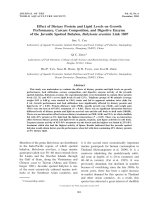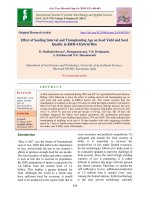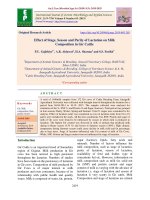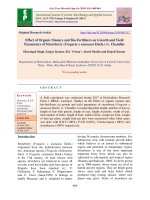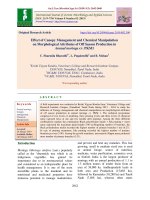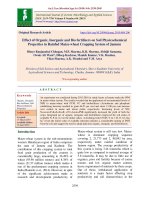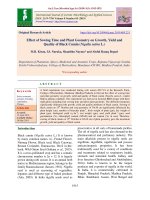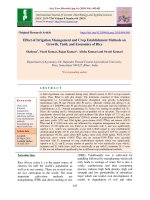Effect of variable protein and energy diet on purine derivatives excretion and quantitative microbial protein production in crossbred and indigenous calves
Bạn đang xem bản rút gọn của tài liệu. Xem và tải ngay bản đầy đủ của tài liệu tại đây (269.17 KB, 10 trang )
Int.J.Curr.Microbiol.App.Sci (2018) 7(11): 2257-2266
International Journal of Current Microbiology and Applied Sciences
ISSN: 2319-7706 Volume 7 Number 11 (2018)
Journal homepage:
Original Research Article
/>
Effect of Variable Protein and Energy Diet on Purine Derivatives
Excretion and Quantitative Microbial Protein Production in
Crossbred and Indigenous Calves
Ajay Singh1* and Bandla Srinivas2
1
Animal Nutrition, College of Veterinary Sciences (Sri Venkateswara Veterinary University),
Proddatur – 516360, Andhra Pradesh, India
2
I/c Dairy Production Section, Southern Regional Station ICAR-NDRI, Bengaluru – 560030,
Karnataka, India
*Corresponding author
ABSTRACT
Keywords
Nutrient intake,
Genotypes, Phenotypic
plasticity, Microbial
protein
Article Info
Accepted:
18 October 2018
Available Online:
10 November 2018
Study was conducted to evaluate the effect of enhanced level of nutrition on nutrient intake
and microbial protein (MBP) production of two genotypes; Deoni and HF crossbred
calves. Treatment groups of Deoni (DTG) and HF crossbred (XTG) were fed 30% more
protein and energy as compared to their respective control groups (CGs). Dry matter intake
(DMI) of DTG was reduced by 18% in comparison to DCG. Crude protein (CP) intake in
DTG was 312 g/d and was higher by 14% compared to DCG. Whereas, CP intake in XTG
was 38% more compared to XCG. Gross energy (GE) intake by DTG was 8.13 Mcal/d
compared to 9.70 Mcal/d of DCG. The MBP production in XCG, XTG, DCG and DTG
was 239, 229, 143 and 142 g/d, respectively. Quantitative availability of MBP was
constant and related to size of the calf. This indicated that the DMI in Deoni calves was
regulated by the nutrient density of diet indicating towards the low level of phenotypic
plasticity of digestive system in Deoni calves providing less scope for productive
improvement by nutritional intervention compared to HF crossbred calves.
Introduction
Nutrition is the primary entity to be look after
for better body growth. Faster growth entails
more amounts of nutrients input through the
diet. Often growth slumps immediately after
weaning due to shift in nutrition from high
density nutrient diet to roughage-based diet
with supplements. And also, nutrition is all too
often neglected between weaning and 9
months of age. Weaning to 9 months of age is
a critical time in the life of a calf and is a time
of higher nutrient requirements. As rumen
capacity is limited during this period, a diet
high in protein and energy content should be
provided. In absence of adequate nutrition, the
average daily weight gain (ADG) of calves
would be less than genetic potential and fails
to obtain required body weight as per the age.
Insufficient growth rates result in an older age
at first calving (Van Amburgh et al., 2008)
which ultimately affects the overall productive
life of the animal. Diet with CP content of 17
to 18% (DM basis) is recommended for calves
2257
Int.J.Curr.Microbiol.App.Sci (2018) 7(11): 2257-2266
less than 250 kg BW (Kertz et al., 1987).
Brosh et al., (2000) have noted higher weight
gain in male HF calves fed high protein diet
(14.6%) in comparison to feeding medium
(12.6%) or low (10.6%) CP diets. Whereas,
Lohakare et al., (2006) found a diet with
12.6% CP can provide adequate digestible
protein at the intestine for the growth. Purine
derivative (PD) excretion in the urine has
proved to be a useful index of microbial
protein flow to the small intestine of
ruminants (Chen et al., 1990; Balcells et al.,
1991). The efficiency of microbial nitrogen
supply (EMNS), in terms of g microbial N/kg
varies at different level of intake (Liu et al.,
2000). Researchers have suggested that the
urinary excretion of PD could be used as a
predictor of the MBP supply in intact animals
(Arndt et al., 2015; Wang et al., 2015).The
purpose of this investigation was to study the
effects of increased protein and energy level in
the diet on intake and microbial protein
production pattern.
Materials and Methods
Location of study
Experiments were conducted at Livestock
Research Centre, Southern Regional Station,
ICAR-NDRI, Bengaluru. The latitude (Φ),
longitude (λ) and elevation of the
experimental place is 12.947014°N (12° 56'
49.2504'' N), 77.607679 (77° 36' 27.6444'' E)
and 921 m from mean sea level, respectively.
The climate here is tropical. The summers are
much rainier than the winters in Bengaluru.
This climate is considered to be Aw according
to the Köppen-Geiger climate classification.
The temperature here averages 23.6 °C. In a
year, the average rainfall is 831 mm. The
driest month is January, with 1 mm of rain.
The greatest amount of precipitation occurs in
September, with an average of 182 mm. April
is the warmest month of the year. The
temperature in April averages 27.1 °C. The
lowest average temperatures in the year occur
in December, when it is around 20.7 °C. There
is a difference of 181 mm of precipitation
between the driest and wettest months. The
variation in temperatures throughout the year
is 6.4 °C ( />4562/). The experiment was conducted
between September 2016 and February 2017.
Experimental design and management of
Animals
The experimental design was a randomized
complete block design with four treatments
and five replications. Weaned female calves of
Deoni and HF crosses at the age of 3 months
were selected ten each for the study and
randomly distributed into 4 equal groups; 1)
Deoni Control Group (DCG), 2) Crossbred
Control Group (XCG), 3) Deoni Treatment
Group (DTG) and 4) Crossbred Treatment
Group (XTG).The mean birth weights of
Deoni and HF cross calves were 19.90±2.02
and 29.40±4.67 kg respectively. The body
weights (BW) at the start of experiment were
61.90±4.45 and 64.70±6.18 kg for Deoni and
Crossbred (CB) calves respectively. Calves
were housed in a well-ventilated shed having
arrangement for individual feeding, well
maintained drainage channels and covered
with laterite clay tiles on a 15 ft wall with 45°
inclination on 6 ft stone pillars. All the
experimental animals were kept under
confinement in individual stalls under tail to
tail systemand were provided free access to
water. Animals were dewormed with generic
product ‘Fenbendazole’ (Panacur® Vet, M/s
Intervet India Pvt. Ltd.) prior to starting of
experiment.
Feeding of animals
Based on the NRC (2001) recommendation
and earlier records of growth rate, nutrient
requirement for the CG of Deoni and
crossbred calves was calculated. TG of Deoni
2258
Int.J.Curr.Microbiol.App.Sci (2018) 7(11): 2257-2266
and crossbred weaned calves were provided
30% enhanced protein and energy over,
respective CGs. Calves were fed mixed
grasses
consisted
of
Para
grass
(Brachiariamutica),
Hybrid
Napier
(Pennisetumglaucum X P. purpureum), Maize
(Zea mays) and Guinea grass (Megathyrsus
maximus) as green roughage sources and CS
pellet (M/s Karnataka Milk Federation [KMF],
Bangalore). CG and TG of Deoni and
Crossbred weaned calves were fed, respective
diets for a period of 6 months. Weighed
quantities of CS were fed once daily at 8 AM.
Mixed green grasses were fed at 10:00
AM.The ingredient composition and nutritive
values of diets are presented in Table 1.
Urine collection
Feeding trial and sample collection
Feed (offered and residue) and faecal samples
collected during the digestibility trial were
analysed for proximate principles and cell wall
constituents (CWC) as per AOAC (2012).
Proximate principles and CWC was
determined as difference between total intake
and faecal output.
CG and TG of Deoni and Crossbred weaned
calves were fed, respective diets for a period
of 6 months. Digestibility trial was conducted
after a preliminary period of feeding for 5
months. Trial was consisted of 5 d collection
period. Feeding schedule of the calves during
the trial period was also maintained as
described above. Diet offered as well as
refused
(orts)
was
weighed
daily.
Representative samples of of each feedstuff
offered, and residues were collected every day
for evaluating the DM and for further
laboratory analysis. Faecal sampling was done
every day at 9:00 AM. The total quantity of
faeces voided by each animal during 24 h was
recorded, thoroughly mixed with gloved hands
and composite sample of 150 to 200 g faeces
was taken separately for each animal in clean
dry polythene bags for further sub-sampling.
Sub-sample of 1/100 of total faeces was taken
for DM estimation i.e., about 50 to 60 g. Dried
samples of feed offered, orts, and feces were
pooled for 5 d. Another sub-sample of 1/400
of total faeces was preserved with known
quantities of 10% H2SO4 (V/V) in pre-weighed
glass bottles for nitrogen estimation.
Spot urine sample was collected 2-3 times a
day for 3-4 d at different time. 20 ml of
sample was collected from each calf every
time and were filtered using four layers of
cheesecloth following the method described
by Balcells et al., (1992) and mixed with equal
quantity of dilute sulphuric acid (2% H2SO4)
to avoid volatilization of ammonia and stored
at -20°C. Finally, one sample of each calf is
pooled from all the samples of the same
animal and were stored at -20°C and preserved
till further analysis.
Chemical analysis
Microbial protein estimation
Microbial nitrogen (MBN) production was
estimated from the spot urine samples using
purine derivatives (PD) and creatinine as
markers in the urine (Chen et al., 1995). Urine
samples were thawed, and 20 ml aliquots were
taken, centrifuged and filtered through a
Millipore filter of 0.2 µm pore size (M/s
Sigma Aldrich, Cat no. F-1387). One ml of the
filtrate was taken and diluted 10-fold with
HPLC grade water after adjusting the pH to
7.0 using 0.01 N NaOH and 0.01 N H2SO4. 20
µl of processed sample was injected into
HPLC. Allantoin, creatinine and uric acid in
the urine were estimated using HPLC method
(Aswin and Srinivas, 2015). Standard
solutions of allantoin (M/s Sigma Aldrich, Cat
no. 93791), creatinine (M/s Sigma Aldrich,
Cat no. C4255) and uric acid (M/s Sigma
Aldrich, Cat no. U0081) each containing
2259
Int.J.Curr.Microbiol.App.Sci (2018) 7(11): 2257-2266
50µg/ml (w/v) of respective standards was
separately prepared in HPLC grade water.
HPLC (M/s Waters India Pvt., Ltd.) was run
in isocratic condition using C-18 reversephase column (M/s Waters India Pvt., Ltd.,
and 4.5 × 260 mm I.D., 5µm) with 10mM
potassium dihydrogen phosphate (pH 4.7) as
mobile phase. Flow rate was fixed at 1
ml/minute and reading was taken at 220 nm
wavelength (Model 2489 UV/visible detector,
M/s Waters India Pvt., Ltd.,). Peaks were
standardized for allantoin, uric acid and
creatinine by injecting 20 µl of respective
standard.
Intestinal flow of MBN was calculated from
the excretion of PD as
Excretion of total PD was calculated as below
(Chen et al., 1995):
Statistical analysis
PDC index: It was calculated as the ratio of
the concentrations of PD (mM/L) to creatinine
(mM/L) times the metabolic body weight
(MBW)
PDC Index = [(PD mM/L)/ (Creatinine
mM/L)] *MBW
The following equation was used to determine
the
quantitative
relationship
between
absorption of purines and excretion of PD (Y
mM/d) in urine.
Y = 83X+0.296 kg W0.75).
(X × 70)/(0.83 × 0.116 × 1000).
Where, the digestibility of microbial PD was
0.83, N concentration in purine was 70 % and,
0.116 was the ratio between N in PD to total N
in mixed rumen microbes.
Efficiency of MBN production was expressed
as g N kg-1 of OM digested in the rumen
(DOMR) by multiplying digestible OM by
0.65.
Statistical analysis of data was performed
using statistical package for social science
(SPSS, ver.20.0 M/s IBM India Pvt. Ltd.). The
data were analysed in a completely
randomized design and significant variation
between means was denoted by different
superscripts. Pairwise comparison between
group means was tested by Duncan multiple
range test (DMRT). Significant difference
between groups was expressed at probability
(P) levels ranging from < 0.10 to 0.01 and p
value of < 0.10 was demarcated using ‘•’
where as ‘*’ and ‘**’ were used to denote P
value of < 0.05 and 0.01, respectively and
validated against null hypothesis (H0).
Where W0.75 represents the MBW (kg) of the
experimental calves. The slope of 0.83 in
equation represented the recovery of absorbed
purines as PD in urine and X was PDC index.
Results and Discussion
In crossbred cattle, the endogenous
contribution was taken as a constant at
0.296W0.75 per day (Singh et al., 2007; Pimpa
et al., 2001; Chen and Orskov, 2003). Thus,
the daily purine absorption was backcalculated as
The chemical composition analysis of the
experimental
feeds
items
constituting
treatment diets is presented in Table 1. DM
and CP content of green grass which was
mixture of non-legume grasses was 19.72%
and 5.10%, respectively. The average CP
content of the CS was 16%. Density of CP,
NFC and energy in GNJ supplement was 63%,
X = (Y-0.296 × W0.75) ÷ 0.83.
Chemical composition of basal diet and
supplement
2260
Int.J.Curr.Microbiol.App.Sci (2018) 7(11): 2257-2266
74% and 10% higher than CS. The
combination of GNC and Jaggery were
supplemented to enhance intake of protein and
energy by the calves.
Feed and nutrient intake
Nutrient intake from the total diet in different
groups is given in Table 2. DMI from total
diet was significantly less in DTG (P ≤ 0.01)
compared to DCG, XCG and XTG where later
groups were statistically (P = 0.08)
comparable. Similarly, OM and TCHO was
also significantly less in DTG (P ≤ 0.01) but,
comparable between the crossbred groups. CP
intake was significantly low in DCG (P≤
0.01). Total OM (P≤ 0.01), EE (P≤ 0.01) and
TA (P≤ 0.01) intake in XTG was higher than
XCG. GE intake was significantly different
among all the groups with DTG having the
lowest value of 8.13 MCal/d whereas, XTG
the intake was found highest (13.73 MCal/d)
(Fig. 1)
Chemical composition of basal diet and
supplement
DM and CP content showed that the green
grass fed was matured and leafy with
moderately tender stems. CP content of leftover green fodder was lesser than offered
whereas NDF content was higher thus,
indicated the selective intake of animals by
taking more tender leafy parts and shoots but
leaving behind the comparatively hard and
fibrous parts like thickened stems with nodes
and internodes (Antongiovanni and Sargentini,
1991). The CP content of the concentrate
was16% which is considered average as
according to Paulson (2009) the best CP% for
dairy animals is 11 to 12%, 13 to 14% and 16
to 17%, respectively in low, medium and high
protein CS based on health and environment.
Excess protein in the ration may have
detrimental effect on kidney and body
extremities e.g., hooves, tail etc.
Microbial Protein Production
Feed and nutrient intake
Excretion of PD in urine and their index, MBP
production with efficiency in different groups
is presented in Table 3. Urinary allantoin
excretion was significantly (P ≤ 0.01) higher
in TGs compared to respective CGs. Total PD
was significantly low (P ≤ 0.01) in DCG
whereas it was comparable in XCG, XTG and
DTG (P = 0.051). Similar was the case found
regarding daily PD excretion with significant
(P ≤ 0.01) high value for HF crossbred calves.
The MBP production in XCG, XTG, DCG and
DTG was 239, 229, 143 and 142 g/d,
respectively. Daily MBP production was
significantly (P ≤ 0.01) high in HF crossbred
calves compared to Deoni animals. MBP
production observed in XCG and XTG were
239 and 229 g/d and comparable to adult
crossbred cows. The efficiency of MBP
production in relation to DOMI and ME intake
was found insignificant (P = 0.15) among the
groups (Fig. 2).
DMI of DTG was reduced by 18% in
comparison to DCG. In-spite of less DMI, CP
intake in DTG was higher by 14% compared
to DCG because of higher protein in GNJ
(26%) than pelleted CS (16%). In case of
Deoni calves, OM, TA and TCHO intake were
less in DTG and more in DCG while contrary
was true for their EE intake. Although GNJ
was rich in CP and GE (4 Mcal/kg), GE intake
by Deoni calves of TG (8.13 vs. 9.70 Mcal/d)
was 20% lesser (P≤ 0.01) than CG. This
indicated that the DMI in Deoni calves was
regulated by the satiety of CP intake. Diet
composition has been suggested to have a
large impact on satiety and satiation. It is
generally
believed
that
the
major
macronutrients differ in their effects, with
protein having a greater effect than
carbohydrate, which has a greater effect than
fat (Hall et al., 2012). Singh and Srinivas
2261
Int.J.Curr.Microbiol.App.Sci (2018) 7(11): 2257-2266
(2016) observed 50% lesser DMI with CS
having 88% soymeal compared to CS having
42% soymeal as protein source thus, high
protein supplements have been reported to
limit DMI. Deoni calves in TG were restricted
their intake with 14% higher protein intake
but, GE intake was 16% lesser. In contrary,
DMI of HF crossbred calves in TGs were not
traded off even after consuming 38% higher
protein and 10% GE. This showed limitation
in phenotypic plasticity of digestive system to
food intake in Deoni calves in comparison to
HF crossbred calves. Phenotypic plasticity of
digestive system has been explained as
compensating low quality diet with higher
intake to fulfil nutrients requirement to the
animals or not limiting the total intake even
when the density of nutrients is higher. In case
of Deoni calves, metabolic finity is reached
either in terms of quantity or quality of the
diet thus, indicated less scope to improve any
productive performance of these calves.
Table.1 Chemical composition of dietary ingredients
Parameter
Moisture (%)
Dry Matter (%)
Organic Matter (%)
Crude Protein (%)
Ether Extract (%)
Total Ash (%)
Acid Insoluble Ash (%)
Total Carbohydrates (%)
Cell Content (%)
Neutral Detergent Fiber (%)
Acid Detergent Fiber (%)
Hemicelluloses (%)
Celluloses (%)
Acid Detergent Lignin (%)
Non-Fibrous Carbohydrates (%)
Gross Energy (Kcal/kg DM)
Green fodder
Offered
80.28 ± 0.37
19.72 ± 0.37
89.61 ± 0.58
5.10 ± 0.13
1.75 ± 0.05
10.39 ± 0.58
3.09 ± 0.11
82.76 ± 0.56
34.27 ± 0.72
65.73 ± 0.72
41.19 ± 0.99
24.53 ± 1.08
33.70 ± 0.72
4.99 ± 0.23
17.03 ± 0.32
3672 ± 24
Concentrate
supplement
11.25 ± 0.23
88.75 ± 0.23
87.79 ± 0.45
15.59 ± 0.58
2.86 ± 0.36
12.21 ± 0.45
2.43 ± 0.25
69.34 ± 0.66
57.07 ± 0.19
42.46 ± 0.27
11.03 ± 0.40
31.43 ± 0.29
7.80 ± 0.25
3.61 ± 0.19
26.88 ± 0.61
3655 ± 23
50% GNC +
50% Jaggary
7.05 ± 0.42
92.95 ± 0.42
93.61 ± 0.68
26.12 ± 0.23
5.35 ± 0.06
6.39 ± 0.68
0.90 ± 0.04
62.15 ± 0.48
84.59 ± 0.21
14.95 ± 0.39
11.41 ± 0.21
3.54 ± 0.48
8.04 ± 0.07
2.83 ± 0.09
47.21 ± 0.47
4022 ± 27
Table.2 Nutrient intake (kg/d) from total diet in different groups
Parameter
DM
OM
CP (g/d)
EE
TA
TCHO
GE (Mcal)
XCG
XTG
DCG
Nutrient Intake (kg/d)
3.41c
3.65c
2.63b
c
c
3.04
3.22
2.36b
3.79c
5.22d
2.75a
0.073b 0.139d 0.055a
0.362c 0.436d 0.277b
2.59c
2.60c
2.03b
12.55c 13.73d 9.70b
2262
DTG
2.14a
1.90a
3.12b
0.083c
0.241a
1.53a
8.13a
SEM
P Value
0.09
0.08
0.07
0.01
0.01
0.07
0.34
0.01
0.01
0.01
0.01
0.01
0.01
0.01
Int.J.Curr.Microbiol.App.Sci (2018) 7(11): 2257-2266
Table.3 Purine derivatives excretion and Microbial Nitrogen production in different groups
Parameter
Allantoin (mM/L)
Uric acid (mM/L)
Creatinine (mM/L)
Total PD (mM/L)
PD index
PD excretion (mM/d)
Duodenal flow of MBN (g/d)
Efficiency of prod. (g N/kg of DOMI)
Efficiency of prod. (g N/Mcal of ME)
XCG
13.51b
4.22
2.00ab
17.74b
296.29b
284.44b
239.15b
131.31
35.60
XTG
18.45c
5.44
2.87b
23.89b
284.27ab
272.90b
229.34b
104.94
26.78
DCG
8.42a
2.44
1.63a
10.86a
213.59a
171.94a
143.09a
102.84
28.37
DTG
17.70bc
3.67
3.05b
21.37b
210.91a
169.79a
141.56a
108.05
27.97
Fig.1 Nutrient intake (kg/d) of nutrients in different groups
Fig.2 MBP production in different groups
2263
SEM
1.42
0.97
0.35
1.92
25.13
23.38
20.00
10.35
2.75
P Value
0.01
0.23
0.04
0.01
0.06
0.01
0.01
0.24
0.15
Int.J.Curr.Microbiol.App.Sci (2018) 7(11): 2257-2266
It is also a classic example for less plasticity
of digestive system of Deoni calves where
high protein intakes are limited by the aminopeptide N in digestive system (Dewitt et al.,
1998).
Microbial protein production
Allantoin excretion in DTG was about 2 times
higher than DCG. It was only 36% higher in
XTG than XCG. This indicated higher
metabolism of microbial PD at small
intestine. Significantly low (P = 0.04)
creatinine concentration in DCG indicated the
direct relationship with body weight and less
metabolically active tissue (Oser, 1965).
Srinivas and Singh (2011) reported excretion
of 3.0 to 3.4 mM/L creatinine. Significant (P
= 0.06) breed difference was observed for the
PDC index where HF crossbred calves were
having higher PDC index. This indicated
more MBP hydrolysed at small intestine in
comparison to metabolically active tissue in
the crossbred calves or vice-versa with Deoni
calves. Urinary PD and duodenal flow of
purine bases differs among species (Chen et
al., 1990) and within cattle species (Liang et
al., 1994). MBP production in ruminants is
influenced by various biological, physical and
chemical factors pertaining to animal, feed
and environment in rumen (Srinivas and
Krishnamoorthy, 2013). Diet composition is
important in MBP yield. MBP yield on grainbased diets were higher (Singh and Srinivas,
2016) than oilseed meals (Mohanavel and
Srinivas, 2016). Grains which contain more
starch is a principle component of NFC and
its availability influences the rumen MBP
production. Quantitative availability of MBP
was constant and related to size of the cow in
general and, rumen in particular. MBP
production in crossbred cows was reported as
low as 80 g/d to 270 g/d on straw diet without
or with CS, respectively (Srinivas and Gupta,
1997). MBP production efficiency was
100g/kg DOMI which was higher than the
optimum suggested 30 g/kg DOMR
(digestible OM in rumen) where DOMR was
65% of digestible OM (DOM) intake (ARC,
1980). Optimum MBP production for kg
DOM intake would be about 50 g. In the
present study, it was 2 folds more while Singh
and Srinivas (2016) reported 50% efficiency
on grain-based diet in Deoni cows compared
to present study. Mohanavel and Srinivas
(2016) reported 30 to 39% on different types
of oilseed-based CS as against the present
study. By and large, the MBP production
efficiency observed in the post-weaned calves
was high irrespective of HF crossbred or pure
Deoni breed that can be attributed to diet.
Total diet intake or digestible nutrients intake
in weaned Deoni calves in comparison to HF
crossbred calves was hindered due to limited
phenotypic plasticity of digestive system.
Thus, Deoni calf response to enhanced protein
and energy would be limited by its capacity to
dry matter intake and protein intake.
Acknowledgements
The authors extend their appreciation to
National Dairy Research Institute (NDRI) for
funding this work and for their support.
Compliance with ethical standards
The study was approved by the committee of
ethics in Animal Experimentation.
Conflict of interest
The authors declare that they have no conflict
of interests
References
Antongiovanni, M. and Sargentini, C. 1991.
Variability in chemical composition of
straws. Options Mediterraneennes Serie
Seminaires. 16: 49-53.
2264
Int.J.Curr.Microbiol.App.Sci (2018) 7(11): 2257-2266
AOAC, 2012) Official Methods of Analysis.
Association of Official Analytical
Chemist. 19th Edn. Washington, DC.
ARC 1980. The nutrients requirements of
ruminant livestock. 4th Edition, CAB
International, Wallingford.
Arndt, C., Powell, J. M., Aguerre, M. J.,
Crump, P. M. and Wattiaux, M. A.
2015. Feed Conversion Efficiency in
Dairy Cows: Repeatability, Variation in
Digestion and Metabolism of Energy
and
Nitrogen,
and
Ruminal
Methanogens, Journal of Dairy Science.
98(6): 3938-3950.
Balcells, J., Guada, J. A., Castrillo, C. and
Gasa, J. 1991. Urinary excretion of
allantoin and allantoin precursors by
sheep after different rates of purine
infusion into the duodenum. J. Agric.
Sci., Camb. 116: 309.
Balcells, J., Guada, J., Peiró, J., and Parker,
D., 1992. Simultaneous determination
of allantoin and oxypurines in
biological fluids by high-performance
liquid chromatography, Journal of
Chromatography
B:
Biomedical
Sciences and Applications, 575, 153–
157.
Brosh, A., Aharoni, Y., Levy, D. and Holzer,
Z. 2000. Effect of dietary protein
concentration and source on the growth
rate and on body composition of
Holstein-Friesian male calves. Anim.
Sci. 70: 527-536.
Chen, X. B. and Orskov, E. R. 2003. Research
on urinary excretion of purine
derivatives in ruminants: past, present
and
future.
In:
Development,
standardization and validation of
nuclear
based
technologies
for
estimating microbial protein supply in
ruminant livestock for improving
productivity. IAEA 2003, Vienna. Pp.
1-34.
Chen, X. B., De, F. D., Hovell, B., Orskov, E.
R. and Brown, D. S. 1990. Excretion of
purine derivatives by ruminants: Effects
of exogenous nucleic acid supply on
purine derivative excretion by sheep.
British Journal of Nutrition 63: 131.
Chen, X. B., Mejia, A. T., Kyle, D. J. and
Orskov, E. R. 1995. Evaluation of the
use of the purine derivative: creatinine
ratio in spot urine and plasma samples
as an index of microbial protein supply
in ruminants: studies in sheep. J. Agric.
Sci., Camb. 125: 137-143.
Dewitt, T. J., Sih, A. and Wilson, D. S. 1998.
Costs and limits of phenotypic
plasticity. Trends in Ecology and
Evolution. 13: 77-81.
Hall, Kevin D., Heymsfield, Steven B.,
Kemnitz, Joseph W., Klein, Samuel.,
Scholler, Dale A. and Speakman John
R. 2012. Energy balance and its
components: implications for body
weight regulation. American Journal of
Clinical Nutrition 95: 989-994.
Kertz, A. F., Prewitt, L. R. and Ballam, J. M.
1987. Increased weight gain and effects
on growth parameters of Holstein heifer
calves from 3 to 12 months of age.
Journal of Dairy Science 70: 1612–
1622.
Liang, J.B., Matsumoto, M., Young, B.A.
1994. Purine derivative excretion and
ruminal microbial yield in Malasyan
cattle and swamp buffalo. Animal Feed
Science and Technology 47: 189–199.
Liu, Z. J. and McMeniman, N. P. 2000.
Microbial Protein Production Estimated
by Urinary PD Excretion and the Ratio
of PD: Creatinine in Spot Urine
Samples for Sheep Fed Lucerne Chaff
at Different Levels of Intake. Asian
Australasian Journal of Animal
Sciences. 13: 31-33.
Lohakare, J. D., Pattanaik, A. K. and Khan, S.
A. 2006. Effect of dietary protein levels
on the performance, nutrient balances,
metabolic profile and thyroid hormones
2265
Int.J.Curr.Microbiol.App.Sci (2018) 7(11): 2257-2266
of crossbred calves. Asian-Aust. J.
Anim. Sci. 19: 1588-1596.
Mohanavel, S. and B. Srinivas 2016. Rumen
microbial and milk protein production
on different source of oilseed meals in
mixed diet of Deoni cows. Indian
Journal of Animal Science 86 (12): 8589.
National Research Council (NRC). 2001.
Nutrient Requirements of Dairy Cattle.
7th rev. ed. Natl. Acad. Sci.,
Washington, DC.
Oser, B. L., 1965, Hawk’s physiological
chemistry. 14th ed. McGraw-Hill, New
York, NY.
Paulson, J. 2009. Feeding dairy animals in
21st century. Dairy Star. 16 October
2009.
/>re/dairy/farm-life/
feeding-dairyanimals-in-the-21st-century.
(DoA:
12/02/2017).
Pimpa, O., Liang, J. B., Jelan, Z. A. and
Abdulla, N. 2001. Urinary excretion of
duodenal purine derivatives in KedahKelantan cattle. Animal Feed Science
and Technology. 92: 203-214.
Singh, A. P. and Srinivas, B.2016. Source of
carbohydrates from different grains on
rumen microbial protein and milk
production in native dairy cows. Animal
Feed Science and Technology 16(2):
297-306.
Singh, M., Sharma, K., Dutta, N., Singh, P.,
Verma, A. K. and Mehra, U. R. 2007.
Estimation of rumen microbial protein
supply using urinary purine derivatives
excretion in crossbred calves fed at
different levels of feed intake. Asian
Australasian Journal of Animal
Sciences. 20(10): 1567.
Srinivas, B. and Gupta, B. N. 1997, Rumen
fermentation, bacterial and total volatile
fatty acid (TVFA) production rates in
cattle fed on urea-molasses-mineral
block licks supplement. Animal Feed
Science Technology 65:275-286.
Srinivas, B. and Krishnamoorthy, U. 2013.
Panoply of microbial protein production
in ruminants – A Review. Indian
Journal of Animal Science 83: 331-346.
Srinivas, B., Swain, N., and Singh, N. P.
2011. Quantification of nutritional
sustenance and microbial protein
production of sheep during different
physiological stages in semi-arid
regions. Indian Journal of Animal
Sciences (India).
Van Amburgh, M. 2008. Early life
management and long-term productivity
of dairy calves. Proceedings of
Southwest
Dairy
Management
Conference. zona.
edu/swnmc/ 2008. (05-11-2016).
Wang, C. 2015. A Modified Machine
Learning Method Used in Protein
Prediction
in
Bioinformatics,
International Journal Bioautomation.
19(1): 25-36.
How to cite this article:
Ajay Singh and Bandla Srinivas. 2018. Effect of Variable Protein and Energy Diet on Purine
Derivatives Excretion and Quantitative Microbial Protein Production in Crossbred and
Indigenous Calves. Int.J.Curr.Microbiol.App.Sci. 7(11): 2257-2266.
doi: />
2266

